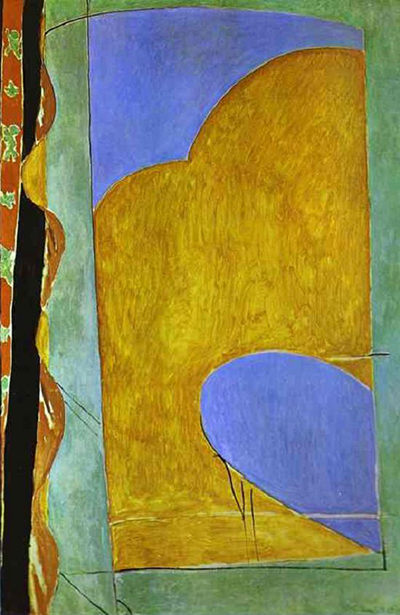Le Rideau Jaune, to give it its original French title, is an unusually abstract painting from the career of Henri Matisse. Whilst he worked in a mixture of different styles across his career, there are not many comparable pieces to this one.
The artist produced many still life and indoor scenes within his career, perhaps inspired by the strong French tradition for attention to objects of everyday life as a means to practicing and developing one's technical skills. Matisse himself was shocked found in the precision of The Ray by Chardin, for example, but his own indoor-based paintings would be much more modern and abstract in style. The example found in front of us here is limited in detail, with a sweeping flurry of yellow tones alongside blue. There is then a green frame with loose black lines. To the far left is a solid black column and some patterned motifs in green or orange. One might argue that the piece is not finished, but actually this is just precisely the finish intended by Matisse, and can be found in other artworks from around this period in his career.
The original title of this artwork was simply, Composition, which underlines how he was unsure as to whether to tell the artist what they are looking at, or not. In the end he goes for the more traditional titling, which explains how this is an abstract view of a yellow curtain. The 20th century in general was full of artists looking to seemingly confuse as with untitled or loosely titled paintings that were intended to avoid biasing what we see ourselves. One of the best examples of that would have to be Mark Rothko, with the likes of Untitled (1952) and No.3/No.13. In some cases it would actually be left to the curators to produce their own ways of differentiating artworks in order to identify the different components of their exhibitions. Mondrian would also do the same himself, even though he had started his career with a much more traditional style, with many landscapes of the Dutch countryside. These were then followed by abstract blocks of colour with ambigious names such as Composition with Red Blue and Yellow.
The painting is around 1 1/2 metres tall, and 1 metre wide. It can be found in the impressive collection of the Museum of Modern Art, New York City. They serve 19th and 20th century art particularly well, with a focus on American and European artists. It is seen by many to be perhaps the most important modern art gallery in the entire US, which is quite a claim considering the good number of other venues that can be found here. There are those which specialise on a particular artist, whilst others continue to draw in crowds who prefer to see a wider selection of art history which helps them to learn more about the different movements and styles that have occured in recent centuries. In one sense, despite the other distractions available in leisure time, the art world has never been so well supported and its importance to the tourism trade is also entirely understood.




